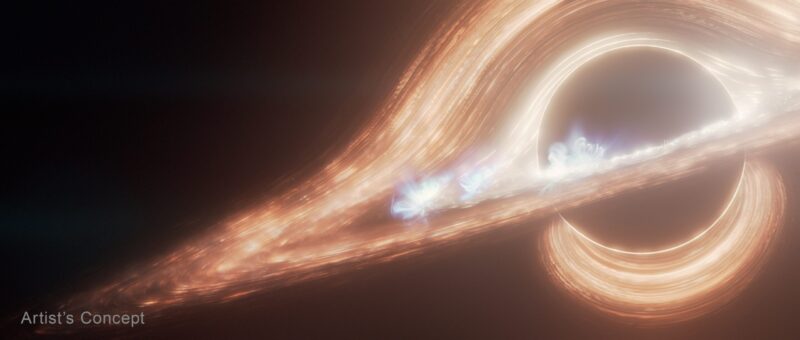- The Webb space telescope has spotted flares and flickers coming from the monster black hole at the center of our Milky Way galaxy.
- Scientists compare these flares to solar flares, except it’s more dramatic because the environment around a black hole is much more extreme.
- These black hole fireworks don’t follow a pattern. Watch the video to see them randomly flicker, brighten and flare.
NASA published this original article on February 18, 2025. Edits by EarthSky.
The Milky Way’s black hole flickers and flares
The supermassive black hole at the center of the Milky Way appears to be having a party, complete with a disco ball-style light show. Using NASA’s James Webb Space Telescope, a team of astrophysicists has gained the longest, most detailed glimpse yet of the “void” that lurks in the middle of our galaxy.
They found the swirling disk of gas and dust (or accretion disk) orbiting the central supermassive black hole, called Sagittarius A*, is emitting a constant stream of flares with no periods of rest. The level of activity occurs over a wide range of time, from short interludes to long stretches. While some flares are faint flickers, lasting mere seconds, other flares are blindingly bright eruptions, which spew daily. There also are even fainter changes that surge over months.
The new findings could help physicists better understand the fundamental nature of black holes, how they get fed from their surrounding environments and the dynamics and evolution of our own galaxy.
The study published in the February 18 issue of The Astrophysical Journal Letters.
Lead author Farhad Yusef-Zadeh of Northwestern University in Illinois said:
In our data, we saw constantly changing, bubbling brightness. And then boom! A big burst of brightness suddenly popped up. Then, it calmed down again. We couldn’t find a pattern in this activity. It appears to be random. The activity profile of this black hole was new and exciting every time that we looked at it.
Random fireworks
To conduct the study, Yusef-Zadeh and his team used Webb’s NIRCam (Near-Infrared Camera) to observe Sagittarius A* for a total of 48 hours in 8- to 10-hour increments across one year. This enabled them to track how the black hole changed over time.
While the team expected to see flares, Sagittarius A* was more active than they anticipated. The observations revealed ongoing fireworks of various brightnesses and durations. The accretion disk surrounding the black hole generated five to six big flares per day and several small sub-flares or bursts in between.
Here’s a timelapse of the flickering black hole at the center of the Milky Way. Video via NASA, ESA, CSA, Farhad Yusef-Zadeh (Northwestern), Howard Bushouse (STScI), Alyssa Pagan (STScI). ?
— EarthSky (@earthskyscience.bsky.social) February 18, 2025 at 10:59 AM
Two separate processes at play in the Milky Way’s black hole
Although astrophysicists do not yet fully understand the processes at play, Yusef-Zadeh suspects two separate processes are responsible for the short bursts and longer flares. He posits that minor disturbances within the accretion disk likely generate the faint flickers. Specifically, turbulent fluctuations within the disk can compress plasma (a hot, electrically charged gas) to cause a temporary burst of radiation. Yusef-Zadeh likens these events to solar flares:
It’s similar to how the sun’s magnetic field gathers together, compresses, and then erupts a solar flare. Of course, the processes are more dramatic because the environment around a black hole is much more energetic and much more extreme. But the sun’s surface also bubbles with activity.
Yusef-Zadeh attributes the big, bright flares to occasional magnetic reconnection events. This is a process where two magnetic fields collide, releasing energy in the form of accelerated particles. Traveling at velocities near the speed of light, these particles emit bright bursts of radiation. Yusef-Zadeh said:
A magnetic reconnection event is like a spark of static electricity, which, in a sense, also is an ‘electric reconnection.’
Dual vision
Webb’s NIRCam can observe two separate wavelengths at the same time (2.1 and 4.8 microns in the case of these observations). So Yusef-Zadeh and his collaborators were able to compare how the flares’ brightness changed with each wavelength. Yet again, the researchers were met with a surprise. They discovered events observed at the shorter wavelength changed brightness slightly before the longer-wavelength events. Yusef-Zadeh said:
This is the first time we have seen a time delay in measurements at these wavelengths. We observed these wavelengths simultaneously with NIRCam and noticed the longer wavelength lags behind the shorter one by a very small amount … maybe a few seconds to 40 seconds.
This time delay provided more clues about the physical processes occurring around the black hole. One explanation is that the particles lose energy over the course of the flare. As in, they lose energy quicker at shorter wavelengths than at longer wavelengths. Such changes are expected for particles spiraling around magnetic field lines.
Aiming for an uninterrupted look
To further explore these questions, Yusef-Zadeh and his team hope to use Webb to observe Sagittarius A* for a longer period of time, such as 24 uninterrupted hours, to help reduce noise and enable the researchers to see even finer details. Yusef-Zadeh said:
When you are looking at such weak flaring events, you have to compete with noise. If we can observe for 24 hours, then we can reduce the noise to see features that we were unable to see before. That would be amazing. We also can see if these flares repeat themselves or if they are truly random.
Bottom line: Using the Webb space telescope, scientists have observed a flickering and flaring coming from the disk of the Milky Way’s black hole.
Source link
Read More
Visit Our Site
Read our previous article: James Webb Space Telescope finds our Milky Way galaxy’s supermassive black hole blowing bubbles (image, video)
